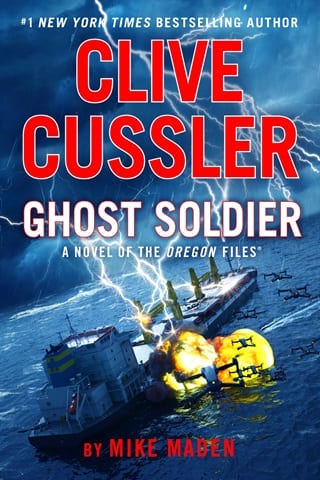Chapter 26
26
Aboard the Izanami
The Indian Ocean
The Vendor pulled away from the microscope on his lab desk. He yawned and stretched his tall, muscular frame to work out the kinks in his back from sitting too long. He’d been so deep into his mental “flow state” that he’d lost all track of time. The ability to concentrate his brilliant mind entirely on a single problem for hours on end was his ultimate superpower. It allowed him to make incredible breakthroughs over the years, and ultimately, to build the vast organization he now controlled.
His primary challenge with getting into such a flow state was losing the ability to stay abreast of other events needing his immediate attention. His solution to that challenge was a heavy reliance on automated systems to track and execute decisions quickly and reliably without his input.
The Vendor’s bleary eyes suddenly popped open when the overhead alarm sounded. He called out in a loud voice to his AI assistant, Keiko, available to him in every department throughout the ship.
“Keiko, why the alarm?”
“Flight number 252 out of Kabul self-destructed three hours ago.”
The Vendor swore. That could only mean something went terribly wrong.
“Why am I only hearing about this now?”
“The nature of the alarm was not a Priority One threat. Also, you silenced the audible alarm when you came into the lab to work. I have been sending visual alarms, but you have not responded to them. As per my protocols, I overrode the audible prohibition after the allotted time.”
The Vendor glanced over at the nearby station. A warning light was, indeed, blinking.
He swore again. Keiko was still too “programmed” in her thinking. He was still trying to work out the algorithms that would allow her to take more initiative in threat assessments. But that was a problem for another day.
He hobbled over to the computer station.
“Keiko, pull up the last fifteen minutes of 252’s internal video feeds and put it on my screen.”
“Certainly.”
A moment later, the video screen was filled with a dozen separate CCTV images.
“Keiko, edit these video files so that they produce a single narrative organized chronologically.”
“Just a moment, please.”
Seconds later, the twelve small screens merged into a single large one.
The Vendor scrubbed through the newly assembled movie. He stopped when the bound figure—an American undercover operative, according to Banfield—began to move. He leaned in close to watch the squirming American work his way out of his bondage. Impressive.
Especially the part with his prosthetic leg.
“Those idiots,” the Vendor said. The Taliban had done a poor job of securing the American. They should have known better.
When he had received the warning from Banfield about an American agent attempting to infiltrate his arms network in Kabul, the Vendor’s first instinct was to turn him over to the medieval savages for torture and information extraction. But the Afghani methods for such procedures were far too crude. Their insensitivities to suffering—particularly American suffering—meant they couldn’t be trusted not to kill him before they extracted useful information about his identity and other necessary details.
But clearly the decision to hand the American over to his contact in Bangui for a chemical interrogation was a mistake. That mistake cost him a valuable shipment and an even more valuable aircraft.
Banfield’s scant information about the American was enough to convince the Vendor to capture him. But now he understood this was clearly no ordinary undercover agent. The man was skilled enough in his black arts to fool Yaqoob, his deeply suspicious Taliban operative, and to penetrate into the most sensitive part of his Afghan operation. All previous American attempts had been easily discovered and defeated.
He wanted to know who this man was, who sent him and, more importantly, what he may have actually discovered. But there were so many moving parts to his master plan that he didn’t dare engage with this particular distraction. No doubt his ego had been wounded by this enterprising fellow, but this was no time to indulge in schoolboy emotions.
No, what he really needed to do now was kill the man before he could pass along his information. The question was, what did he actually know?
The Vendor studied the rest of the digital images up until the moment the man leaped from the plane with his cleverly improvised parachute harness. Seconds later, the aircraft exploded, destroying all onboard cameras, rendering the collated image on his monitor into a blizzard of digital snow.
The Vendor rewound the tape and played it again, searching for clues. He saw several things that piqued his curiosity.
“Keiko, show me where the plane self-destructed.”
Another monitor winked into life and a Google-styled map appeared. A flashing red dot indicated the approximate location of the crash over the Gulf of Oman beyond the border of Pakistan.
“Keiko, plot a probable landing location of a man, say, ninety to ninety-five kilos in weight parachuting from the plane’s last known location. Include prevailing wind and weather information, along with last known aircraft speed and altitude in your calculations.”
“Calculating.”
Moments later, a small light blue circle appeared on the water far from shore. Keiko added, “Probable landing location is within this zero-point-three-square-kilometer zone.”
The Vendor estimated it would take the agent hours to swim to land from that location—assuming he could make the journey at all.
“Do we have any air or sea assets near that zone?” The Vendor possessed an eidetic memory and he was certain there were none, but he had learned long ago that humility was a far more reliable asset than perfect recall.
“None.”
The Vendor noticed the American had made a phone call to someone. That would only be possible with a satellite phone—there were no cell towers in the Gulf of Oman. The phone appeared to be a commercially available device.
“Keiko, search the video and identify the brand of device the intruder used to make the satellite call.”
The Vendor watched Keiko rewind the video and then scrub it forward at blinding speed until the video froze on a single frame showing the American holding the satellite phone.
Keiko put an image box around the man’s hand, which held the phone a few inches from his face. Keiko enlarged the box image by a factor of six hundred percent, which pixelated it, smudging it out of all recognition.
“Keiko, upscale the image.”
“Already in process.” Even as she spoke, the smudged image filled in until a crystal clear picture appeared. The satellite phone could be easily seen in Juan’s hand. The Vendor read the brand before Keiko even spoke.
“I believe that is a Thuraya X5-Touch phone,” Keiko said.
“Is that the same UAE company that provides mobile-satellite service to the region?”
“Yes. One and the same.”
Keiko pulled up the Thuraya website and began reading from it.
“ ‘The Thuraya X5-Touch is the world’s first Android-based satellite and GSM phone offering unparalleled flexibility—’ ”
“Keiko, stop reading. How many satellites does Thuraya operate?”
“Thuraya operates two geosynchronous satellites.”
“Do we have access to both?”
“We compromised both in prelaunch construction via one of our network associates.”
“Keiko, I want you to determine which of those two satellites the phone in question utilized to make its call. Second, I want you to access that satellite and acquire the metadata from that call. Third, from that metadata I want you to determine the location of the receiver of that call. Am I clear?”
“Perfectly. Please give me one moment.”
The Vendor twitched with agitation. Something wasn’t adding up.
“The call was received,” Keiko said, “by a vessel currently located approximately seventeen point seven kilometers west of the center of the estimated parachute landing zone.”
“Pull up an AIS information screen for the Gulf of Oman. Overlay and center it onto the landing zone. Display every ship within one hundred kilometers of the landing zone.”
According to international maritime law, every passenger ship no matter its size and every cargo vessel displacing over three hundred tons was required to broadcast an automated identification system signal for maritime traffic control and safety. Almost as quickly as the Vendor had given his AI assistant the order, a cluttered array of over forty ship icons appeared on the screen. The icons were various shapes and colors corresponding to the types of vessels.
“Keiko, eliminate all of the ships except the one receiving the sat call.”
Instantly, all of the vessels disappeared save a yellow triangle.
Several more screens quickly followed. The surly weapons designer grunted with satisfaction. Keiko had anticipated his next command and cycled through the data until a picture of the vessel, its dimensions, destination, and name all appeared.
“The Norego…Iranian-flagged,” the Vendor read aloud.
“TheNorego is still located approximately seventeen point seven kilometers west of the center of the parachute landing zone. It appears to be holding its position.”
“That’s still too far for a swim,” the Vendor said aloud. And then it hit him. “Wait! You said the alarm sounded three hours ago. Go back to the AIS screen. Show me the Norego’s position three hours ago.”
The yellow triangle instantly appeared sixty kilometers southwest of its current position.
The Vendor frowned. “Play forward at five-times speed to the current time.”
“Playing forward.”
Keiko did precisely as instructed. The Vendor was surprised to see the Norego race to the center of the parachute landing zone.
“Keiko, freeze the image.
“That doesn’t make any sense,” the Vendor said as he compared the elapsed time to the distance traveled. “Keiko, how fast was the Norego traveling in that sixty-kilometer stretch?”
“Approximately 110.01 kilometers per hour.”
“A ship that size? Impossible!”
“Apparently ‘knots,’ ” Keiko said. She giggled at her own pun.
“Stop your nonsense,” the Vendor growled. “And disable your humor function.”
“Humor function disabled.”
The Vendor stared at the flashing yellow icon. That was no ordinary ship. It was a spy vessel of some sort with incredibly advanced engine technology.
And given the fact it had anchored at the parachute landing site, it no doubt had picked up the agent. What happened next?
“Play forward at two-times speed.”
The Norego tracked west away from the parachute landing zone until it came to a stop exactly where they had first identified it a few moments ago.
The Vendor checked the time on the monitor and confirmed it was the current hour and minute. Why was the Norego anchoring there right now? Hadn’t it already picked up the agent?
“Keiko, on this same map, plot the probable debris field of Flight 252 under prevailing weather conditions at the time of the explosion.”
“This will take a moment.”
“Don’t dawdle.”
“Wouldn’t think of it.”
The Vendor’s eyes were fixed on the screen. Moments later, a proposed debris field appeared, marked in green.
And the Norego was parked right in the middle of it.
“That ship is trying to recover my cargo!”
“That is my estimation as well.”
That didn’t make any sense. The Gulf of Oman was too deep. Unless…
“Keiko! Lock on to that vessel with a targeting package and send that data to missile launchers one and two.”
“Task completed.”
“Keiko…Launch!”
 Fullepub
Fullepub 



